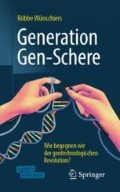Zusammenfassung
Die Gesamtheit der Erbinformation eines Lebewesens, das Genom, verteilt sich beim Menschen auf 46 Chromosomen, von denen je eine Hälfte von den Eltern geerbt wurde. Insgesamt ist es aus rund 3,2 Milliarden DNA-Bausteinen zusammengesetzt und codiert für etwa 20 Tausend Proteine. Bei der Japanischen Einbeere verteilen sich 149 Milliarden Bausteine auf zehn Chromosomen. Die Größe des Genoms steht nur eingeschränkt mit der Komplexität eines Lebewesens in Beziehung. Der genetische Code bestimmt sowohl welche Proteine gebildet werden, aber auch wann und wo. Daraus resultiert ein morphogenetischer Code, der die Form von Geweben und Lebewesen bestimmt. Neueste Erkenntnisse zeigen, dass das DNA-Molekül nicht nur Träger der sehr stabilen genetischen Information ist. Zusätzlich können zu Lebzeiten erworbene Informationen epigenetisch am DNA-Molekül codiert und vererbt werden.
Access this chapter
Tax calculation will be finalised at checkout
Purchases are for personal use only
Literatur
Weber-Lehmann J, Schilling E, Gradl G, et al (2014) Finding the needle in the haystack: Differentiating „identical“ twins in paternity testing and forensics by ultra-deep next generation sequencing. Forensic Sci Int: Genet 9: 42–46. https://doi.org/10.1016/j.fsigen.2013.10.015
Heuser UJ, Tatje C (2019) Danke, Diesel. Die Zeit: 11/2019, S. 17
Löbbert R (2019) Meine innere Kirche brennt. Die Zeit: 10/2019, Beilage Christ & Welt, S. 1
Bittner J (2019) Brexit: Im Tollhouse. Die Zeit Ausgabe 5, S. 3
Leipziger Messe GmbH (2019) Preis der Leipziger Buchmesse 2019. In: YouTube. Aufgerufen am 21.03.2019: youtu.be/YZuadUiFtYo bei Minute 30
Pellicer J, Fay MF, Leitch IJ (2010) The largest eukaryotic genome of them all? Bot J Linn Soc 164: 10–15. https://doi.org/10.1111/j.1095-8339.2010.01072.x
Liu F, van Duijn K, Vingerling JR, et al (2009) Eye color and the prediction of complex phenotypes from genotypes. Curr Biol 19: R192–R193. https://doi.org/10.1016/j.cub.2009.01.027
The 1000 Genomes Project Consortium (2012) An integrated map of genetic variation from 1,092 human genomes. Nature 491: 56–65. https://doi.org/10.1038/nature11632
The 1000 Genomes Project Consortium (2015) A global reference for human genetic variation. Nature 526: 68–74. https://doi.org/10.1038/nature15393
Monod J, Jacob F (1961) Teleonomic mechanisms in cellular metabolism, growth, and differentiation. Cold Spring Harb Symp Quant Biol 26: 389–401. https://doi.org/10.1101/sqb.1961.026.01.048
Elfer M (2018) Transporter mit Pkw-Genen. Mitteldeutsche Zeitung, Rubrik Auto & Verkehr, 29/30 Dezember 2018; S. 1
Redaktion (2010) Wort des Jahres 2010: Der „Wutbürger“ sticht alle aus. In: Frankfurter Allgemeine Zeitung. Aufgerufen am 14.04.2019: faz.net/1.581941
Pearson H (2006) Genetics: what is a gene? Nature 441: 398–401. https://doi.org/10.1038/441398a
Dawkins R (2006) The Selfish Gene. Oxford University Press, New York/USA
Yanai I, Martin L (2016) The Society of Genes. Harvard University Press, Cambridge Massachusetts/USA
Juhas M, Eberl L, Glass JI (2011) Essence of life: essential genes of minimal genomes. Trends Cell Biol 21: 562–568. https://doi.org/10.1016/j.tcb.2011.07.005
Hutchison CA, Chuang R-Y, Noskov VN, et al (2016) Design and synthesis of a minimal bacterial genome. Science 351: aad6253. https://doi.org/10.1126/science.aad6253
Fischer EP (2017) Treffen sich zwei Gene. Siedler Verlag, München
Hutchison CA, Newbold JE, Potter SS, Edgell MH (1974) Maternal inheritance of mammalian mitochondrial DNA. Nature 251: 536–538. https://doi.org/10.1038/251536a0
Luo S, Valencia CA, Zhang J, et al (2018) Biparental Inheritance of Mitochondrial DNA in Humans. Proc Natl Acad Sci USA 115: 13039–13044. https://doi.org/10.1073/pnas.1810946115
McWilliams TG, Suomalainen A (2019) Mitochondrial DNA can be inherited from fathers, not just mothers. Nature 565: 296–297. https://doi.org/10.1038/d41586-019-00093-1
Lutz-Bonengel S, Parson W (2019) No further evidence for paternal leakage of mitochondrial DNA in humans yet. Proc Natl Acad Sci USA 116: 1821–1822. https://doi.org/10.1073/pnas.1820533116
Luo S, Valencia CA, Zhang J, et al (2019) Reply to Lutz-Bonengel et al.: Biparental mtDNA transmission is unlikely to be the result of nuclear mitochondrial DNA segments. Proc Natl Acad Sci USA 116: 1823–1824. https://doi.org/10.1073/pnas.1821357116
Sykes B (2002) The Seven Daughters of Eve. Corgi, London UK
Wilmut I, Campbell K, Tudge C (2001) Dolly. Carl Hanser Verlag, München
Sudmant PH, Rausch T, Gardner EJ, et al (2015) An integrated map of structural variation in 2,504 human genomes. Nature 526: 75–81. https://doi.org/10.1038/nature15394
Gudbjartsson DF, Helgason H, Gudjonsson SA, et al (2015) Large-scale whole-genome sequencing of the Icelandic population. Nat Genet 47: 435–444. https://doi.org/10.1038/ng.3247
Haeckel E (1899) Kunstformen der Natur. Verlag des Bibiographischen Instituts, Leipzig und Wien
Borek E (1973) The sculpture of life. Columbia University Press, New York/USA
Turing AM (1952) The chemical basis of morphogenesis. Philos Trans R Soc, B 237: 37–72. https://doi.org/10.1098/rstb.1952.0012
Holdrege C (1999) Der vergessene Kontext: Entwurf einer ganzheitlichen Genetik. Verlag Freies Geistesleben, Stuttgart
Carroll SB (2005) Endless Forms Most Beautiful. W. W. Norton & Company, New York/USA
Gregory TR (Edt) (2011) The Evolution of the Genome. Elsevier Academic Press, Burlington, Massachusetts/USA. https://doi.org/10.1016/B978-0-12-301463-4.X5000-1
Denyer T, Ma X, Klesen S, et al (2019) Spatiotemporal Developmental Trajectories in the Arabidopsis Root Revealed Using High-Throughput Single-Cell RNA Sequencing. Developmental Cell 48: 840–852.e5. https://doi.org/10.1016/j.devcel.2019.02.022
Deans C, Maggert KA (2015) What Do You Mean, „Epigenetic“? Genetics 199: 887–896. https://doi.org/10.1534/genetics.114.173492
Tucci V, Isles AR, Kelsey G, et al (2019) Genomic Imprinting and Physiological Processes in Mammals. Cell 176: 952–965. https://doi.org/10.1016/j.cell.2019.01.043
Weiterführende Literatur
Fontdevila A (2011) The Dynamic Genome. Oxford University Press, New York/USA
Mukherjee S (2017) Das Gen. S. Fischer Verlag, Frankfurt am Main
Carrol SB (2008) Evo Devo. Berlin University Press, Berlin
Author information
Authors and Affiliations
Corresponding author
Rights and permissions
Copyright information
© 2019 Springer-Verlag GmbH Deutschland, ein Teil von Springer Nature
About this chapter
Cite this chapter
Wünschiers, R. (2019). Was ist Erbinformation?. In: Generation Gen-Schere . Springer, Berlin, Heidelberg. https://doi.org/10.1007/978-3-662-59048-5_2
Download citation
DOI: https://doi.org/10.1007/978-3-662-59048-5_2
Published:
Publisher Name: Springer, Berlin, Heidelberg
Print ISBN: 978-3-662-59047-8
Online ISBN: 978-3-662-59048-5
eBook Packages: Life Science and Basic Disciplines (German Language)

